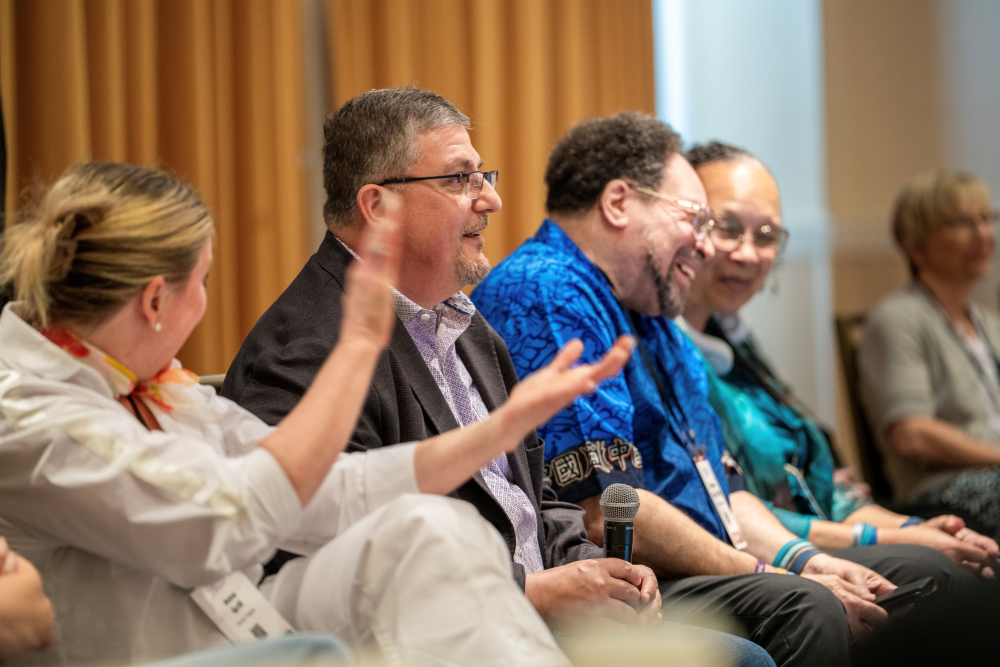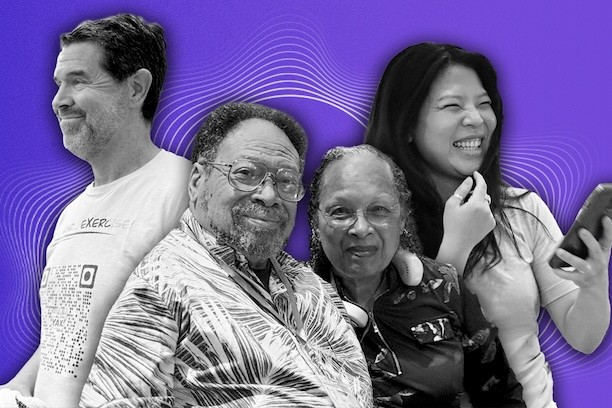At the end of June, we held our 4th annual healthcare provider education conference—ATMRD (Advanced Therapeutics in Movement & Related Disorders). Like every year, this event was a love letter to our community members living with a diagnosis, centering their priorities and their voices, while enhancing existing care networks through interdisciplinary learning and vital peer-to-peer connections for their doctors and healthcare teams.
Building provider empathy and the utilization of speech, occupational, and physical therapy were core themes to the 2025 agenda, offering ACCME accredited Continuing Medical Education (CME) credit to doctors who participated in expert-led, lived experience-informed sessions. “Non-Pharmacological Treatment of Neuropsychiatric Non-Motor Symptoms in Parkinson’s,” taught learners that stress and anxiety can increase fatigue, freezing of gait, and other symptoms. Co-presenter Marcia Smith Pasqualini, PhD shared: “Nearly all people with Parkinson’s have at least one neuropsychiatric symptom. Anhedonia, for instance, is a common symptom in which the person no longer feels pleasure from previously enjoyed activities.” Marcia and her co-presenter Renia Kodabak, LICSW advocated for the use of cognitive-behavioral therapy (CBT) as well as other social supports to reduce isolation and create robust networks of support for both the person with a diagnosis and their care partner. “The mental state of the patient is the biggest predictor of care partner distress,” said Marcia.
Care partner burden and how physicians can support them as well as their patients was a thread woven throughout the four days of learning. Another CME presentation by Jennifer Corcoran, MD was titled: “What Really Helps Patients: Integrating Neuropalliative Care,” which led with the concept of “time toxicity” or the burden of time people with a diagnosis and their care partners spend interacting with the healthcare system. Neuropalliative care is focused on maximizing wellbeing, and Jennifer outlined ways that doctors could integrate concepts throughout their patient care. For instance, she asks care partners: “What has been the hardest part of this for you?” and “Are you getting time to yourself to get your own needs met?”
Many care partners tend to center only the needs and challenges of their loved one, but that’s worse for both parties in the long run. “It can make care partners an appendage in a way that’s not fair,” said Jennifer, cautioning about the risk of care partner burnout. “it’s really hard to un-burnout a care partner.”
Burnout can result in profound exhaustion and overwhelm that can prevent someone from being able to care for their loved one at all. Anticipatory guidance from the healthcare team and robust community support is crucial to prevent this outcome, which damages the wellbeing of the patient as well as their care partner.
Burnout Prevention Through Connection
Much like doctors must be aware of the risks of demoralization and burnout in their patients, they must also be vigilant in guarding against professional burnout for themselves. ATMRD’s focus on holistic support doesn’t end with people with lived experience—it always fosters lasting professional collaborations for healthcare providers and creates pathways for providers early in their careers to connect with potential mentors and leaders in their field. Greater connection and comradery within the provider community serves people with movement disorders in a variety of ways. It not only ensures their doctor has a long list of interdisciplinary contacts they can turn to for opinions on a difficult case, but it also helps to renew providers’ enthusiasm for their work and increase the number of specialists available to serve this growing community.
“ATMRD has broadened my horizons, especially my knowledge of the latest therapeutics,” Monica Sarkar, MD told us. “I otherwise do not get much exposure as a resident, so this is a great learning opportunity every year. Even complex topics like DBS are simplified for a learner like me.”
Like Monica, many neurology residents and early-career physicians tell us that their formal education on movement disorders is limited. This means up and coming doctors don’t get the exposure that can foster interest compared to other specialties. Connecting fellows and residents to in-depth education and inspiring peers is essential to growing the capacity of the healthcare community to meet the growing Parkinson’s and movement disorder needs. With this in mind, PMD Alliance funds ATMRD scholarships for fellows, residents, and advanced practice providers in movement disorders. We also match doctors in training to expert mentors in movement to help guide them in their chosen path.
And this intentional, authentic approach really makes a difference for those who attend and utilize our resources. Monica is a former PMD Alliance medical mentee (also known as CAMP-FiRE) and she had nothing but glowing things to say about our clinician partners and their guidance at ATMRD and beyond.
“Dr. Torres-Yaghi is always brimming with passion and enthusiasm! I have always enjoyed his teaching and the pearls of wisdom that he provides. He has much interest in helping residents and fellows find their way in the field of movement disorders, which I greatly appreciate!” Monica shared with us during the conference. Yasar Torres-Yaghi, MD is a renowned movement disorder specialist and ATMRD Course Director alongside fellow movement disorder specialist Fernando Pagan, MD. These two had a vision and they welcomed the partnership between PMD Alliance and MedStar Georgetown University Hospital to help this conference become the intimate, interdisciplinary hub of movement disorders’ knowledge and passion that we enjoy today.
The interdisciplinary culture and accessibility of content are key to creating a conference that stands out among the neurology landscape. Anyone providing or facilitating medical care for people with movement disorders can register for ATMRD, and you don’t have to have an “MD” after your name to benefit. This is one reason why it’s popular with Advanced Practice Providers (APPs) in movement disorders, as well as researchers and treatment manufacturers.
“This conference has impacted me most by being able to meet other APPs and being able to network in ways to help our patients,” Marcela Casas, DNP told us. “It’s nice to be able to reach out to others. Also, every year I learn something new that makes me a more empathetic provider to my patients.”
“The best part of past ATMRDs has been the connections and community made in this industry to treat movement disorder patients,” shared Ann Marie Diaz, ARNP.
ATMRD’s focus on holistic support and interdisciplinary connections for those in the movement disorder community is unique within the national, in-person CME landscape. In planning ATMRD, we intentionally included meals as a part of all ATMRD tickets, though that’s not typical among conferences like ours.
“Dr. Pagan has always been adamant that feeding people well is essential,” said Anissa Mitchell, LCSW, PMD Alliance Chief Program Officer. “Breaking bread with people from different perspectives fosters collaboration, and we want to ensure that—from our doctors to treatment developers to community leaders with lived experience—everyone feels welcome in the buffet line.”
This is one of the many ways ATMRD creates opportunities for authentic connection that you won’t find elsewhere.
Hands-On Learning & Empathy Building
This year, we kicked off the first two days of learning with early-morning “Movement is Medicine” sessions to give providers firsthand experience with physical and speech therapies they might recommend. We weren’t sure that a pre-breakfast CME session would be in everyone’s comfort zone, but these were highly popular, demonstrating our providers’ staunch commitment to growing their knowledge.
Then, we saved the best for last, closing the event on day 4 with “Empathy in Action,” featuring rotating experiential stations for learners to hear directly from a variety of people with lived experience and participate in activities that helped simulate some of the daily challenges people with movement disorders face. Session facilitator Daniel Irizarry, MD, who is both a treating specialist and a person with young onset Parkinson’s, said this about the session in an interview with NeurologyLive: “With this experience that the clinicians will go through, it will remind them of the need for empathy, despite the challenges of a busy clinical schedule, and the therapeutic value of that empathy may be more valuable than the medicines they prescribe… You have to understand and listen to what the patients’ needs are.”
Empathy-building activities included things like the dexterity station, where learners donned cumbersome gloves and attempted to button and unbutton shirts, fold towels, and more. “This was really difficult. I can see why they get frustrated…especially for someone who doesn’t have a lot of caregiver support,” said Lina Okar, MD.
At the next table over, APP Randi Loomis was trying Thick-It, an often-recommended additive for people with swallowing difficulties to decrease the risk of aspiration pneumonia—the leading cause of death in PD. “That’s terrible. It tastes like glue!” Randi exclaimed about her thickened water. [/vc_column_text][vc_column_text]
“This was really difficult. I can see why they get frustrated.” – Lina Okar, Neurology Resident
At the Action, Gait & Mobility station, participants donned ankle weights, a resistance band around their knees, and slippers with velcro on the bottom, then attempted to walk across a rug, “It feels like a lot of work… It was hard to get my foot off the floor,” Jayant Yadav, Neurology Resident, said, following hooting applause from his peers at making it across.
The Virtual Reality Chorea station, featuring a VR experience from Neurocrine, shed light on yet another facet of the challenges their patients may face. We talked to Movement Disorder Fellow Philip Lee, MD as he left the station. “There was a lot of criticism from the simulation when I struggled,” he shared. “I can see how people would be accused of doing things they’re not trying to do.”
These experiences, combined with in-depth discussions with people with a diagnosis and their care partners, sent doctors home buzzing with new impressions and enthusiasm for their work. “By doing events like this, we all learn we’re on the same team. We’re all the same, some of us just have Parkinson’s,” said Lori DePorter, session facilitator, and ATMRD 2025 truly embodied that energy. It was a celebration of the many ways we can help and learn from each other, and participants left ready to spread that knowledge and compassion to their local communities.
ATMRD 2025 Photo Album
After the event, when discussing the ways it demonstrated PMD Alliance’s love for our community and our dedication to amplifying lived experiences, CEO Andrea Merriam joked: “PMD Alliance loves you so much that we made your doctors put on oven mitts and close tiny shirt buttons.”
And while that was meant to be silly, the sentiment is completely true. We will go the extra mile to create understanding because our community deserves it—healthcare providers included. They want to be the best they can be, and they’re more than willing to try something uncomfortable or embarrassing to better relate to what their patients are going through. That’s the beauty of ATMRD—when everyone’s in the room together, the dynamic changes, unique insights are achieved, and care across the country is enhanced.



